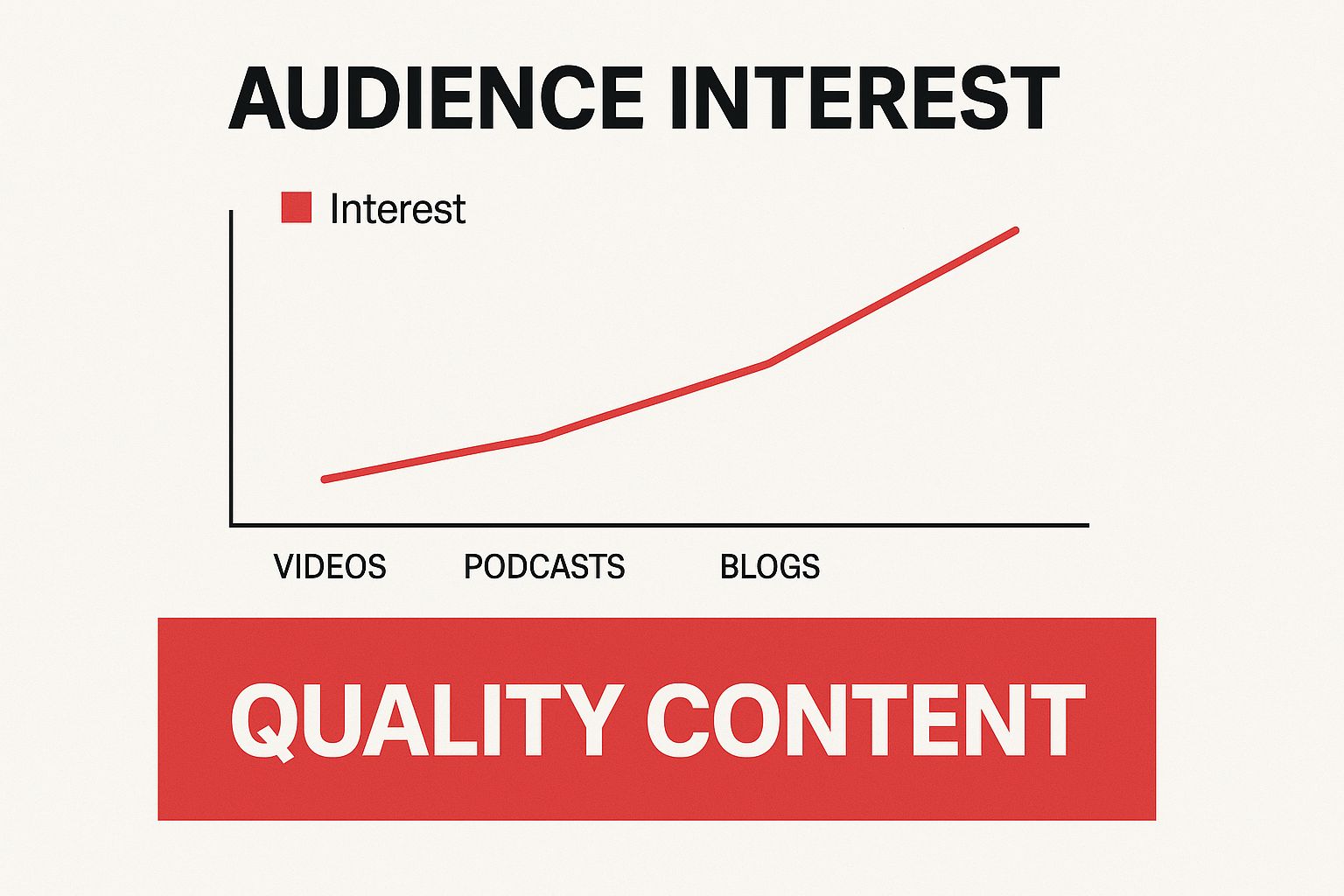Understanding YouTube's Monetization Foundation

Before you start earning on YouTube, it's essential to grasp the core of how it all works: the YouTube Partner Program (YPP). This program unlocks various ways to make money, such as ad revenue, fan funding, and sponsorships. But there are requirements you need to meet to join. These ensure a certain level of content quality and audience engagement, protecting both viewers and your potential earnings.
Breaking Down the YouTube Partner Program Requirements
The YPP has two main levels: one for fan funding and the other for ad revenue. Knowing the difference is key for setting achievable monetization goals. If you want to monetize your YouTube channel with fan funding (like Super Chats and memberships), you need 500 subscribers, three public uploads in the last 90 days, and either 3,000 public watch hours in the past year or 3 million Shorts views in the last 90 days. This lets creators with smaller, engaged audiences begin earning.
But to access ad revenue, you'll need 1,000 subscribers and 4,000 valid public watch hours in the last 12 months or 10 million Shorts views in 90 days. For a complete explanation of these requirements, check out our helpful guide on YouTube monetization requirements. These requirements might seem like a lot, but many creators have successfully met them.
To help illustrate the requirements, take a look at the table below:
YouTube Partner Program Requirements Breakdown: Complete overview of monetization eligibility criteria and alternative options
| Requirement Type | Minimum Threshold | Timeframe | Tips to Achieve |
|---|---|---|---|
| Subscribers (Fan Funding) | 500 | - | Create engaging content that encourages subscriptions |
| Public Uploads (Fan Funding) | 3 | Last 90 days | Maintain a consistent upload schedule |
| Watch Hours (Fan Funding) | 3,000 | Past year | Create high-quality videos that viewers will watch for longer durations |
| Shorts Views (Fan Funding) | 3 million | Last 90 days | Leverage short-form video trends and create compelling Shorts content |
| Subscribers (Ad Revenue) | 1,000 | - | Focus on building a loyal subscriber base |
| Watch Hours (Ad Revenue) | 4,000 | Past 12 months | Optimize video length and content for maximum watch time |
| Shorts Views (Ad Revenue) | 10 Million | Last 90 days | Promote your Shorts and aim for viral content |
This table summarizes the various paths to monetization on YouTube. Focusing on creating engaging content and promoting your channel are key to hitting these milestones.
The Path to Monetization and Beyond
Getting into the YPP is just the first step. Once you’re in, you can continue monetizing your content without needing to reapply, even if your subscriber count changes. This means even if you join with the minimum requirements, you’ll unlock more earning tools as your channel grows. This encourages you to keep making great content and connecting with your audience. Understanding how the YouTube algorithm works is also crucial for boosting your visibility.
Your YouTube success depends on several factors, including knowing the rules, creating strategic content, and consistently engaging with your audience. Now that you know the basics, you can start working towards maximizing your earning potential.
Maximizing Your YouTube Ad Revenue Potential
So, you've reached the YouTube Partner Program milestones—congratulations! Successfully monetizing your YouTube channel takes more than just meeting the eligibility requirements. It's about optimizing your content and channel to bring in the most ad revenue possible. This means knowing what content attracts premium advertisers and understanding how viewer demographics impact your earnings.
For example, content geared towards audiences in higher-income countries tends to attract higher-paying ads. Longer videos also often allow for more ad placements, potentially increasing revenue per video. However, viewer watch time is crucial. Longer videos with low audience retention won't help. Focusing on engaging content is key to successful monetization.
Content Strategies That Attract Premium Advertisers
Some types of content consistently attract higher-paying advertisers. Educational videos, product reviews, and how-to tutorials tend to perform well. These videos draw in viewers with a genuine interest in the subject, making them more receptive to relevant ads. To boost visibility and drive traffic, consider how embedding YouTube videos on other platforms can broaden your reach and increase overall revenue. Embedding YouTube videos can be a powerful tool for expanding your audience.
Building a consistent brand image and producing high-quality videos strengthens trust with your audience and shows advertisers that your channel is a valuable platform for their message. For more in-depth tips, check out this resource on how to master YouTube ads. This consistent approach benefits both you and the brands you partner with.
Leveraging Audience Demographics and Seasonal Trends
Understanding your audience is essential for optimizing ad revenue. Consider factors like age, location, and interests. Advertisers often pay a premium to reach specific demographics. Knowing your audience allows you to create content that attracts those high-value viewers. Monetizing a YouTube channel has become a significant income source for creators worldwide, thanks to the platform's growing advertising revenue.
YouTube's ad revenue reached $8.92 billion in the first quarter of 2025 alone. This represents a 10.3% increase compared to the first quarter of 2024, highlighting the earning potential for creators who successfully monetize their content. For more detailed statistics on YouTube's growth, see this report.
Seasonal trends also impact ad revenue. Some products and services see increased advertising during certain times of the year. Creating content relevant to these trends allows you to take advantage of increased ad spending and maximize earnings during those peak seasons. This proactive strategy contributes significantly to your overall YouTube income plan.
Mastering CPM Rates And Revenue Optimization
After successfully joining the YouTube Partner Program, the next step in effectively monetizing your YouTube channel is understanding and optimizing your CPM, or Cost Per Mille (cost per thousand views). Your CPM can vary significantly, impacting your earnings. Understanding this is key for creators seeking to thrive on YouTube. We'll break down current CPM benchmarks across different content categories and geographic locations, helping you set realistic revenue expectations and identify areas for growth.

This image highlights how quality content attracts viewers and advertisers. High-quality content draws a larger audience and signals to advertisers that your channel is a valuable platform, potentially leading to higher CPM rates. This naturally leads us to explore how content directly impacts earnings.
Decoding CPM Benchmarks and Growth Opportunities
Successfully monetizing your YouTube channel requires a strategic approach. It’s not just about views; it’s about their value to advertisers. In 2025, the standard YouTube CPM is around 2.50 EUR (approximately $2.70 USD) globally. More detailed statistics can be found here. However, this figure varies depending on content type, audience demographics, and viewer location. While the lower end of CPM is around 1.00 EUR, the high end can reach 8.00 EUR, showing how niche or targeted content can command premium ad rates. This highlights the potential to earn significantly more by focusing on a specific audience.
High-Volume vs. Niche: Maximizing Your Time Investment
Many creators focus on high view counts with low CPM. While volume contributes to earnings, it's often less efficient than focusing on a niche audience. Niche content attracts a more engaged audience that's highly desirable to advertisers in that specific market. This results in higher CPMs and a better return on your content creation efforts, allowing you to earn more with fewer views. This maximizes your time and resources.
The following table shows a comparison of average CPM rates across different content categories and geographic markets. It also provides some optimization tips for each category.
CPM Rates by Content Category and Region
| Content Category | Average CPM (USD) | Geographic Region | Optimization Tips |
|---|---|---|---|
| Finance | $5.00 - $10.00 | North America | Focus on investment advice and financial planning topics. Partner with relevant brands. |
| Technology | $3.00 - $7.00 | North America, Europe | Create tutorials and reviews of popular tech products. Stay up-to-date on the latest trends. |
| Gaming | $2.00 - $5.00 | North America, Asia | Stream popular games and create engaging commentary. Build a strong community. |
| Beauty | $1.50 - $4.00 | North America, Europe | Create makeup tutorials and product reviews. Collaborate with other beauty influencers. |
| Lifestyle | $1.00 - $3.00 | Global | Share personal vlogs and lifestyle tips. Be authentic and relatable. |
This table highlights the significant CPM differences across various niches. Finance and Technology typically have higher CPMs due to the high value of their target audiences to advertisers. While Lifestyle content may have lower CPMs, a large audience can still generate substantial revenue. The key takeaway is to understand your niche's CPM potential and optimize accordingly.
Practical Techniques for CPM Improvement
Improving your CPM requires a multi-pronged approach. Focus on audience development by cultivating a loyal community within your niche and understanding their preferences. Optimize your content for viewers and advertisers by creating engaging videos that align with advertiser-friendly guidelines. Finally, experiment with strategic scheduling to identify the optimal publishing times for maximum viewership and ad impressions within your target demographic. These combined tactics enhance your channel's value to advertisers.
Building Multiple Revenue Streams Beyond Ads
Successfully monetizing your YouTube channel means thinking beyond just ad revenue. Smart creators diversify their income to build a more sustainable and profitable online presence. This involves exploring all of YouTube's monetization features, from channel memberships and Super Chat to merchandise shelves and exclusive content. These tools help you connect with your audience on a deeper level while creating various income opportunities.
Expanding Your Monetization Toolkit
Beyond ads, YouTube offers several ways to earn directly from your viewers. Channel memberships allow your audience to support you monthly for exclusive perks like badges, emojis, and members-only content. This creates recurring revenue and fosters a stronger sense of community. Super Chat and Super Stickers offer another way for fans to show their appreciation during live streams. They pay to have their messages highlighted in the chat. These features are especially effective for creators with highly engaged audiences. Additionally, selling merchandise directly through your channel with merchandise shelves can be profitable. It's a great way to monetize your brand and offer tangible products to your fans.
This diversification is crucial. Relying solely on ad revenue can be unpredictable. Factors like fluctuating ad rates and algorithm changes can impact your earnings. Diversifying creates a safety net and a more stable income. Check out this helpful guide: How to master YouTube monetization. It offers valuable insights into maximizing your channel's earning potential.
Affiliate Marketing and Brand Partnerships
Beyond YouTube’s built-in features, affiliate marketing and brand partnerships offer significant revenue potential. Affiliate marketing involves promoting other companies’ products or services. You earn a commission on each sale made through your unique referral link. This works well if you create product reviews or tutorials. For example, a tech reviewer might partner with electronics brands. A beauty vlogger might promote cosmetics. Brand partnerships involve collaborating with companies on sponsored content. You integrate a brand’s message into your videos for a sponsorship fee. These partnerships can be lucrative. It's important to choose brands that align with your channel's values and resonate with your audience.
Diversifying Your Revenue Off-Platform
Many creators use their YouTube presence to generate income off-platform. This can include creating and selling digital products like ebooks or online courses. Some offer consulting services or host paid webinars. By building an audience on YouTube, you establish credibility and expertise. This can be used to build other profitable ventures. This strategy helps creators expand beyond YouTube and create multiple income streams. A fitness YouTuber, for instance, might create a workout program or offer personalized coaching.
Choosing the Right Revenue Streams for Your Channel
The most effective revenue streams depend on your channel’s size, niche, and audience. A smaller channel might focus on building a loyal community through channel memberships and Super Chat. A larger channel with a broad reach might explore brand partnerships and merchandise sales. Experiment with different approaches and analyze the results. This helps you identify the most effective strategies for your audience. This allows you to optimize your efforts and maximize your YouTube earnings.
Creating Content That Drives Sustainable Revenue

Building a successful YouTube channel that consistently earns money takes more than just viral videos. It requires a well-planned strategy for creating content. This involves understanding your audience, finding profitable niches, and making videos that keep viewers coming back. This section will explore proven methods for creating advertiser-friendly content that leads to consistent growth and revenue.
One example is developing a content series instead of one-off videos. This encourages viewers to subscribe and watch more, boosting your watch time and overall channel engagement.
Identifying Profitable Niches and Content Series
A crucial step in monetizing your YouTube channel is finding a profitable niche that isn't overcrowded. This allows you to focus on a specific audience and create content tailored to their interests. Creating a series of videos around a specific topic can greatly increase viewer engagement.
Think of it like a TV show; each episode builds upon the last. This encourages viewers to watch the whole series, increasing your watch time and attracting more advertisers. This can be much more effective than hoping for individual videos to go viral.
Creating Engaging Content for Increased Revenue
Creating videos that naturally lead to more engagement and revenue is essential for long-term success. This means focusing on content that provides value to your viewers, whether it's educational, entertaining, or inspiring. Ask yourself what problems you are solving for your audience. What unique perspective do you bring?
Answering these questions will help you create content that resonates with viewers and encourages interaction with your channel. This engagement, in turn, attracts advertisers who want to reach your audience.
Balancing Trending and Evergreen Content
Finding the right mix of trending topics and evergreen content is vital for sustained revenue. Trending topics can offer quick gains and increase your channel's visibility in the short term. However, evergreen content provides long-term value and continues attracting viewers over time, creating a consistent revenue stream.
This means your content strategy should incorporate both: use trending topics for initial boosts while building a library of evergreen content. This evergreen content will continue generating views and ad revenue long after the trend has passed. Besides YouTube, other platforms offer revenue streams. For example, you can learn how to monetize LinkedIn to diversify your income.
Optimizing Titles, Thumbnails, and Descriptions
Optimizing your video titles, thumbnails, and descriptions is critical for both discoverability and monetization. A compelling title and thumbnail grab viewers' attention and encourage them to click. This boosts your click-through rate and overall views, leading to higher ad revenue. Using relevant keywords in your descriptions helps YouTube understand your content, making it easier to find in search results.
Think of your thumbnail as the cover of a book—it’s the first thing people see. It can influence their decision to watch your video. Investing time in creating high-quality thumbnails is essential for maximizing your earning potential.
Using Analytics To Scale Your Revenue
Data-driven decisions are key to a successful monetized channel. Instead of vanity metrics like subscriber counts, focus on YouTube Analytics to understand metrics that actually correlate with earnings. This means interpreting data like audience retention, traffic sources, and demographics to improve your bottom line.
Interpreting Your Audience Retention
The audience retention graph is a roadmap to better content. High retention shows viewers are engaged and watch your videos completely. This signals value to YouTube, leading to higher rankings and more visibility. Low retention points out areas for improvement, like pacing or content relevance. Addressing these issues directly impacts watch time and ad revenue.
Identifying Your Most Profitable Content
Use YouTube Analytics to see your video's traffic sources. Are viewers coming from YouTube search, external websites, or social media? Understanding this helps refine promotion strategies and focus on the most effective sources for your channel.
Demographic data provides insights into your audience's age, gender, and location. This is important for creating content that appeals to your target demographic and attracts advertisers who want to reach that group. Understanding demographics refines content strategy and helps attract advertisers willing to pay more, increasing your CPM and maximizing ad revenue.
Utilizing Third-Party Tools and Tracking
While YouTube Analytics is a good starting point, third-party tools can offer deeper insights. These tools often provide more granular tracking of monetization strategies. Some specialize in analyzing CPM rates, while others focus on audience engagement and demographic analysis. Using these tools can give you a competitive advantage.
Developing your own tracking methods, like spreadsheets to monitor performance across different monetization strategies (e.g., affiliate marketing or merchandise sales), is valuable. This helps determine which strategies are most effective. By analyzing data and refining your approach, you set up your channel for long-term success.
Key Takeaways
Monetizing your YouTube channel involves understanding the platform, optimizing your content, and finding diverse income streams. This section outlines the key steps for building sustainable income from your YouTube content, from initial setup to advanced strategies. It's a complete roadmap for your monetization journey.
Action Plan for YouTube Monetization Success
-
Meet the YouTube Partner Program (YPP) Requirements: You'll need 1,000 subscribers and 4,000 valid public watch hours in the past year. Alternatively, 10 million Shorts views in 90 days also qualifies. Even with 500 subscribers, you can access features like Super Chats and Memberships.
-
Optimize for Ad Revenue: Focus on high-quality, advertiser-friendly content in profitable niches. Think about who your audience is and what's trending to attract higher-paying ads. Longer videos can mean more ads, but keeping viewers engaged is key to maximizing watch time.
-
Mastering CPM and Revenue: CPM (Cost Per Mille) varies based on factors like your content, audience, and location. The average CPM is around $2.70 USD, but focusing on a specific niche can increase this. Don't just chase views; a valuable audience leads to higher CPMs.
-
Diversify Your Income: Look beyond ads. Explore channel memberships, Super Chat, merchandise, and affiliate marketing. Creating digital products or offering consulting related to your niche can also be lucrative.
-
Content Strategy for Sustainable Revenue: Build a library of evergreen content that consistently attracts viewers. Mix in trending topics for short-term boosts. A content series can encourage binge-watching and increase watch time.
-
Leverage Analytics: YouTube Analytics helps you understand audience retention, where your traffic comes from, and your viewers' demographics. This data refines your content strategy and pinpoints areas for improvement. Track your performance across different monetization methods to optimize your earnings.
Troubleshooting and Scaling Your YouTube Income
-
Rejected from YPP? Don't give up! You can appeal and reapply. Use the time to improve your content, fix any copyright issues, and ensure you’re following community guidelines.
-
Low CPM Rates? Analyze your content and audience. Are you in the right niche? Is your content engaging? Try different strategies and monitor the results.
-
Struggling to Diversify? Start small. Introduce one new income stream at a time. Talk to your audience to understand their needs and what they’d be willing to pay for.
Tracking Your Progress Towards YouTube Income
This simple checklist helps you stay focused:
| Milestone | Action Steps | Success Metrics |
|---|---|---|
| YPP Qualification | Reach subscriber and watch hour goals | Track progress in YouTube Studio |
| Ad Revenue Optimization | Create high-quality, advertiser-friendly content | Monitor CPM and RPM in Analytics |
| Revenue Diversification | Implement multiple income streams | Track earnings from each source |
| Content Strategy | Balance trending and evergreen content | Analyze audience retention and engagement |
By following these key takeaways and continually refining your approach, you can build a successful YouTube channel that generates sustainable income. Want to jumpstart your earnings with monetization-approved accounts? Visit MonetizedProfiles today.








